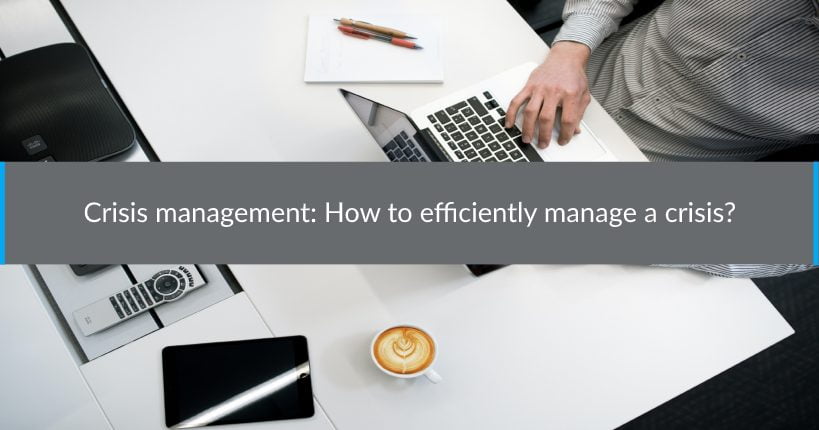You know that sooner or later your business may face a crisis. It can be caused by internal problems (such as a succession of resignations, a loss of an important client or the absence of a manager) or by external factors (economic crisis, natural disasters, shortage of raw materials, transport strikes…).
No matter what the origin of the crisis, the consequences can be catastrophic for the company and jeopardize its future. To avoid this kind of scenario and effectively manage any type of crisis, it is essential to react quickly and take adequate measures to get your business out of the turmoil. Even though there is no miracle solution to effectively manage a crisis, you can follow these 7 steps to set up a feasible crisis management plan.
1. Identify risks.
Good crisis management starts with anticipation of risks that a company may face. Organise a brainstorming session and gather representatives from all departments in order to create a complete list of all potential risks. These can range from a natural disaster to a computer crash, including a work accidents, cyber attacks or defective products.
Nest, analyse every risk to determine its probability of occurring and its impact on the organisation; then establish a ranking. With this in-depth study, you will realise that some risks can be avoided by modifying work processes and changing the current practices. As an example, you could reduce the risk of cyber attacks by investing in efficient antivirus software and by regular cyber security related trainings provided to your employees.
2. Define an action plan
Once you have identified potential risks, you need to define human and material resources to be put in place in order to respond effectively in every crisis situation. A crisis management plan takes into consideration all possible scenarios and provides for operational responses. It may include a Business Continuity Planning (BCP), Business Recovery Plan, evacuation plan, etc.
It is important to be well prepared and to have a response plan ready before a crisis occurs. Why? As you are likely to react differently (less efficiently) under pressure when having to deal with a real crisis situation.
Note that a crisis management plan must be revised and updated regularly as risks are prone to change. It must also be tested to ensure its effectiveness.
3. Establish a crisis unit
A crisis unit is a key place for crisis management. It is a place where the crisis management organization is centralized, response plans are piloted and the crisis communication strategy is implemented.
A crisis unit generally consists of staff members from the company as well as external experts with specific experience in the event of a sensitive or critical situation:
- main decision-makers of the company (managers, service managers, senior managers),
- internal or external experts with knowledge on the nature of the crisis;
- communication and public relations specialists;
- legal advisers, lawyers or insurers.
It is within the crisis cell that decisions are made to deal with the crisis and protect the company, its business and its reputation.
4. Designate and train a spokesperson
In times of crisis, it is essential to carefully coordinate corporate communications in order to preserve company’s image and reputation, but also to show that the situation is under control.
Two main types of communication while in a crisis situation:
- communication which makes it possible to manage the crisis and reduce its impact on business operations(by alerting customers and / or the public, by sending instructions to employees, coordinating operations);
- communication aimed at avoiding scandals and protecting the reputation of the company.
The company must designate who will be its official spokesperson in the event of a crisis. They (there may be more than one) will be the only authorized party to speak on the company’s behalf. They will be seen as an official source of information about company’s position and actions.
The spokespeople are carefully selected and trained to speak through various communication channels.
5. Define messages to transmit
During a crisis, the company needs to address all of its audiences: employees, clients, partners, suppliers, public etc. Messages will therefore vary depending on the intended target, but also depending on the media chosen for the dissemination of information(website, social media, press, etc.). However, keep in mind that the core message should be simple, clear and easily understandable by everyone. Try to be as transparent as possible and avoid denying the existence of the problem at the risk of losing all credibility.
The first messages usually are in the spirit of alert messages. Then, you have to communicate on the evolution of the situation. To avoid your messages being influenced by the stress and pressure present during the crisis situation, do not hesitate to develop them with a close watch at the disaster scenarios that you identified during the first step.
6. Make space for crisis management
When a crisis occurs, it’s time to react by implementing all actions you had prepared in advance. Have you spotted a problem or an abnormal situation? Assess the level of threat and, based on that, launch the crisis unit accordingly, make alerts and put in place the response plan.
7. Stay positive
A crisis is often a real test for the company. However, if well managed, it can create new opportunities by forcing the society to be creative and innovative as well as encouraging them to move forward by bouncing back. Internally, a crisis can be an opportunity to strengthen team cohesion and the employees’ sense of belonging. Externally, it may be seen as an occasion to show the strength, reactivity and resilience of the company.
An effectively managed crisis will improve or strengthen the image and reputation of your business.










